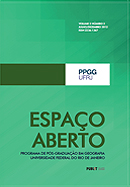Paisagem Arqueológica como Paisagem Cultural: Considerações sobre o Complexo Rupestre do Poti, Piauí – Brasil
DOI:
https://doi.org/10.36403/espacoaberto.2020.32700Palavras-chave:
Arte Rupestre, Paisagem Cultural, Paisagem Cultural ArqueológicaResumo
A importância da noção de preservação do patrimônio arqueológico e do seu contexto é expressa tanto nos pensamentos processuais neo-evolucionistas, que compreendem a cultura como o resultado das relações da tecnologia com o meio ambiente, como para os pós-processualistas contextualistas, cujo enfoque baseia-se na convicção de que os pesquisadores precisam examinar todos os aspectos possíveis de uma determinada cultura arqueológica a fim de compreender o significado de cada parte. Destarte, a aplicação do conceito de Paisagem Cultural Arqueológica permite uma ampliação da noção de sítio arqueológico – de uma unidade isolada, como trata a legislação brasileira até o momento, para o território de atuação de grupos pretéritos. Considerando a importância da preservação do contexto arqueológico na conformação do patrimônio arqueológico, propõe-se que a chancela da Paisagem Cultural passe a ser uma modalidade utilizada como critério para a seleção, ou como uma categoria à parte, numa tentativa de alargamento dos possíveis instrumentos de preservação e salvaguarda deste patrimônio sui generis junto às instituições de proteção, no âmbito nacional e internacional. Como exemplo de aplicabilidade apresenta-se neste trabalho uma das áreas com maior concentração de sítios rupestres do Brasil: o Complexo Rupestre do Poti, localizado no estado do Piauí.


